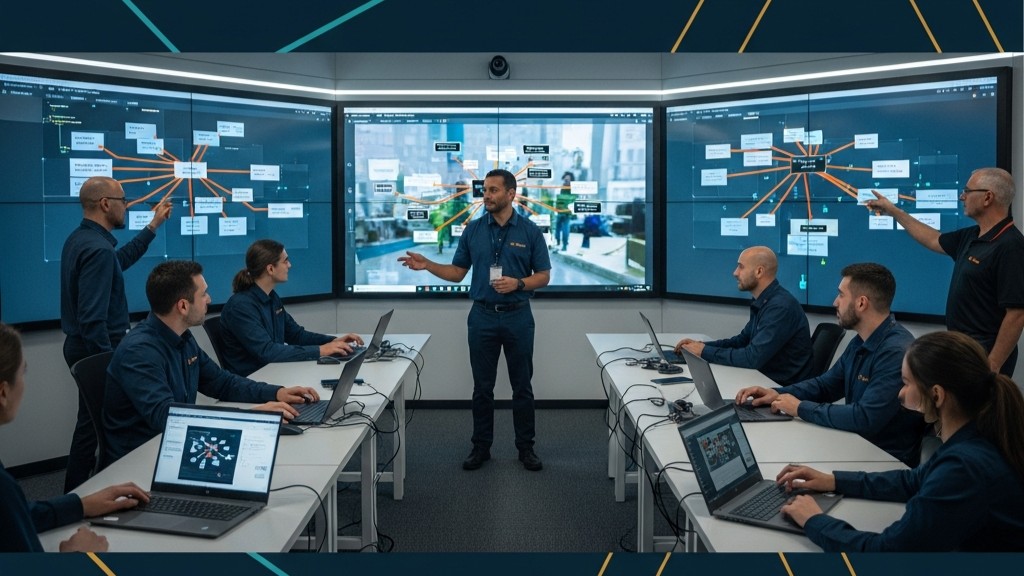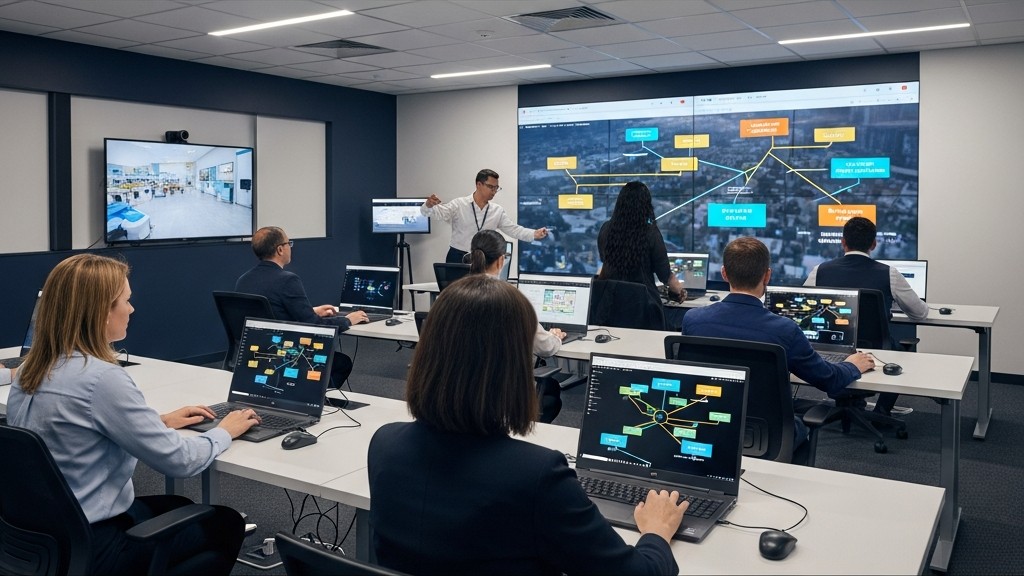What is an incident response tabletop exercise?

An incident response tabletop exercise (TTX) is a discussion-based drill that walks key stakeholders through a simulated incident, closely replicating real-world conditions. Businesses commonly associate incident response exercises with cybersecurity preparedness. However, these exercises also help mitigate broader threat scenarios, from natural disasters to critical infrastructure failure.
Ultimately, they help validate your incident response plan, provide threat intelligence, and prepare your teams for the unexpected. Read on to learn the primary benefits, applications, and challenges of incident response tabletop exercises.
Incident response tabletop exercises: Key benefits
Businesses of all industries, sizes, and regulatory requirements adopt incident response tabletop exercises for two primary reasons: preparedness and compliance.
Organizational preparedness: Unmitigated emergency scenarios can be costly—to reputation, finances, operations and society. Because incident response tabletop exercises simulate real-world environments, they let key stakeholders identify and rectify gaps in their response plans.
Regulatory compliance: The greater an organization’s regulatory complexity, the more often it should conduct tabletop exercises. These exercises validate controls and, when done right, produce audit‑ready evidence of ongoing compliance easily.
Software solutions amplify these benefits. They unify exercise management, increase the simulation’s realism, provide real-time insights, and automate compliance reporting—significantly surpassing the capabilities of traditional TTX methodologies.
Applications of incident response tabletop exercises
During a tabletop exercise, key stakeholders talk through incident response plans step-by-step. These stakeholders typically include:
Incident response team (IRT).
Senior management.
Communications.
IT.
Cybersecurity.
Legal.
Human resources.
Each tabletop exercise also has a dedicated facilitator. Their role is to operate the TTX software platform and help steer the conversation during the incident response exercise, not dominate it. Using software, stakeholders stress-test detection and escalation workflows, rehearse containment, decision making and recovery actions, and extract actionable lessons for continuous improvement. The overarching objective is to strengthen organizational preparedness by simulating realistic threat scenarios.
Tabletop exercises let businesses simulate a broad scope of incidents, including:
Cyberattacks: From simulating ransomware attacks to an insider data breach, tabletop exercises let teams walk through detection, escalation, containment, recovery, and review processes.
Critical-infrastructure disruptions: Critical infrastructure faces ongoing risk, from extreme weather to aging equipment. Tabletop exercises are flexible, letting teams simulate a broad scope of potential threats.
Workplace violence: Tabletop exercises let key stakeholders validate employee-safety protocols and response capabilities, including for situations involving violence. This involves simulating threat recognition, emergency escalation, protective action, and post-incident processes.
PR crisis: Tabletop exercises bring key stakeholders together—communications, legal, executive leaders, and others—to validate PR response plans, from initial alert to reputation recovery.
Incident response tabletop exercise challenges
Organizations commonly face challenges when running tabletop exercises, including stakeholder disengagement, insufficient analytics, and scenarios that lack realism.
Fortunately, advanced software solutions far exceed the capabilities of traditional tabletop exercise methodologies. Here’s how they address the challenges that businesses face.
Stakeholder disengagement
Stakeholders lose interest when scenarios seem unrealistic, repetitive, or irrelevant. Traditional tabletop exercise approaches often produce this problem. These systems depend on facilitator guidance and generic presentations, which limit participation and engagement. Disengaged stakeholders reduce the value of tabletop exercises and create gaps in organizational preparedness.
Advanced tabletop software solutions, like Avalanche TTX, provide realistic, interactive exercises. They minimize disengagement through adaptive, inject‑driven experiences that evolve with participant input. Stakeholders shape scenarios through realistic decision-making, rather than merely observing. This, unlike traditional approaches, fosters dynamic discussions that reflect a real-world incident response process.
Insufficient data
Traditional tabletop exercises can range from a facilitator talking through the scenario, to delivering updates in envelopes, to sharing updates on PowerPoint slides. They typically rely on manual note-taking and basic documentation. These methods often miss key details. Without accurate data, organizations cannot identify genuine gaps, measure performance, or track improvement over time. Weak analytics also hinder compliance reporting.
Advanced tabletop software streamlines data management. It captures critical exercise data in real time, recording stakeholder decisions, interactions, and key actions without manual effort. These capabilities help organizations spot response gaps, verify improvements, and compile compliance evidence.
Unrealistic scenarios
Traditional tabletop exercises often rely on static, generic scenarios that ignore real‑world complexity and an organization’s unique context. This limitation prevents stakeholders from fully testing their incident response plan, so teams enter real emergencies unprepared and overlook critical gaps in detection, containment, and recovery processes. Unrealistic scenarios also fail to evoke the emotional reactions teams experience during real incidents, making participants’ responses less reflective of how they would act under actual pressure. Ultimately, unrealistic scenarios inhibit preparedness, compliance, and stakeholder confidence.
Advanced tabletop software addresses this challenge by offering scenarios that mirror real operational conditions and risks. Organizations can build custom, adaptive scenarios aligned with actual threats and specific business contexts. As one Safety Director of a State Education Department wrote, “[With Avalanche TTX], our team can now make on-the-spot changes to our scenarios easily according to the demands of the audience.”
Avalias, your trusted partner in preparedness
Avalias is a leading provider of tabletop exercise solutions. Avalias’s Avalanche TTX enables standardized training across teams, locations, and scenarios. Whether for single‑team tabletop sessions or multi‑location incident simulations, Avalanche TTX ensures secure, consistent delivery tailored to your needs.
As one Business Continuity Manager wrote, “Avalanche TTX helps us present realistic scenarios that deliver meaningful outcomes to participants who are often time poor and very results-focused.”
Ensure your teams’ preparedness. Learn more about Avalanche TTX today.
Frequently asked questions
What is an example of a tabletop exercise?
Tabletop exercises help guide teams through emergency incidents. This can include simulating cybersecurity incident response plans, where key stakeholders discuss and validate detection, escalation, containment, recovery, and review processes.
Can I customize exercise reports?
Yes. Avalanche TTX lets you import Microsoft Word debrief templates or edit the built-in reports, giving you full control over layout and content.
How long should a tabletop exercise be?
It depends on the tabletop exercise scenario’s complexity. As a general rule, tabletop exercises should be between one to four hours long. This time may increase for complex scenarios involving multiple teams, locations, or spanning multiple phases of incident response.
Advanced software solutions, like Avalanche TTX, reduce the time it takes to create effective tabletop exercises. “I can create a fully immersive exercise in a matter of hours, not days,” one U.S. State Government Emergency Management Specialist and Avalanche TTX user wrote.
Do my scenarios have to have a fixed narrative
No, you can design scenarios with dynamic injects that activate when participants take specific actions. That way, individual decisions trigger a predefined outcome, allowing the exercise to branch into multiple possible paths rather than follow a single fixed storyline.


